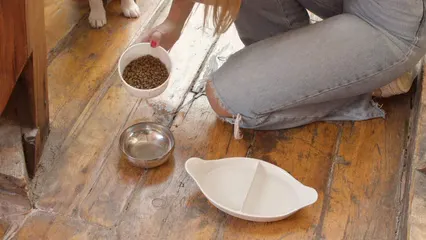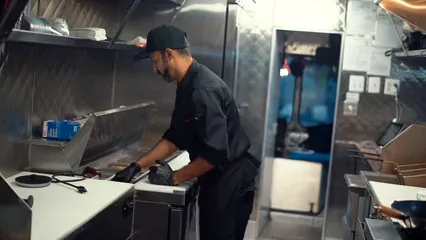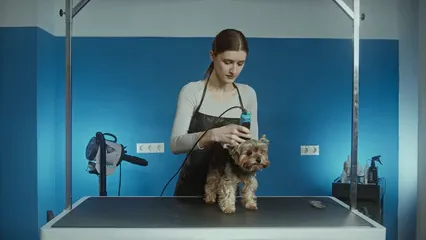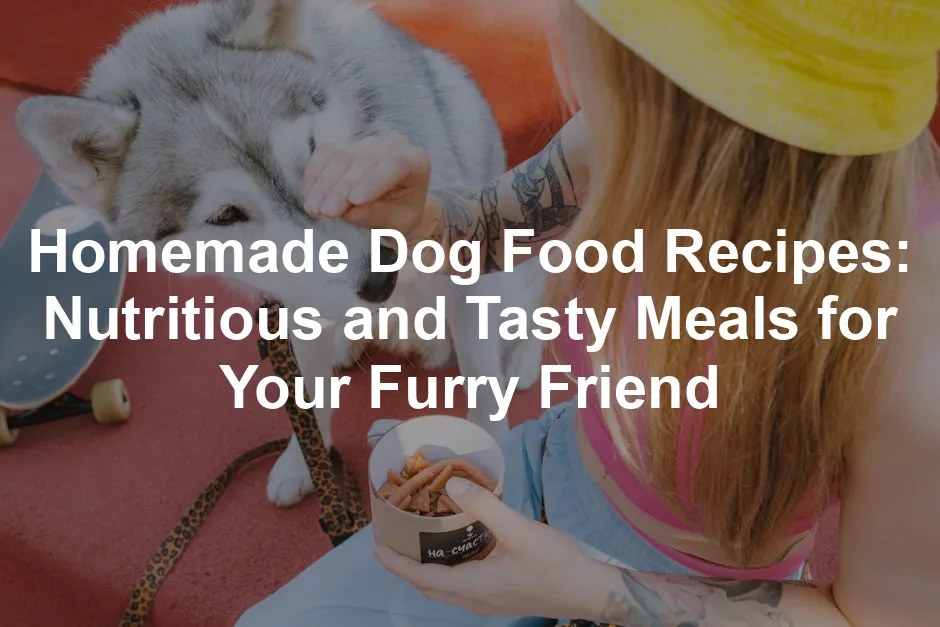Introduction
Are you considering homemade dog food? It’s a great choice! Many pet owners now opt for homemade recipes to provide their furry friends with the best nutrition. This article will share easy and healthy homemade dog food recipes that will keep your pup happy and healthy.
Speaking of keeping your pup happy, every chef needs the right tools! A Dog Treats Baking Kit can make your treat-making experience even more delightful, giving you all the tools you need to whip up something special for your furry friend!
Summary and Overview
A balanced diet is crucial for dogs. Just like us, they need a mix of proteins, carbohydrates, and fats. Homemade dog food allows you to cater to various dietary needs, whether your dog has allergies or is just a picky eater.
We’ll cover a variety of recipes, including vegan options and grain-free meals. Cooking for your dog can be a fun bonding experience. Plus, you can tailor meals to fit their specific needs. Always consult your veterinarian for personalized dietary advice and to ensure your dog gets all the nutrients they require.
And for those who want to keep dog food fresh, a Dog Food Storage Container is essential. It keeps food fresh and free from pests, ensuring your dog’s meals are always tasty!

Section 1: Benefits of Homemade Dog Food
Nutrition Control
When you prepare homemade dog food, you control every ingredient. You know exactly what goes into their meals. This transparency ensures your dog consumes high-quality, nutritious food.
Cost-Effectiveness
Homemade dog food can save you money. While some may think it’s expensive, many recipes use affordable ingredients. In contrast, commercial dog foods often have hidden costs. Making food at home can be budget-friendly and healthier.
Customization for Dietary Needs
Every dog is unique. Homemade meals allow you to customize recipes based on your dog’s health needs. If your dog has allergies or sensitivities, you can easily swap out ingredients. This flexibility helps ensure your dog enjoys their meals and stays well-nourished.
Quality Ingredients
You choose the ingredients for homemade meals. This means you can select high-quality, natural options, avoiding artificial additives. This choice significantly enhances your dog’s overall health.
Bonding Experience
Cooking for your dog can strengthen your bond. Preparing meals together can be fun and rewarding. Your dog will appreciate the effort you put into their meals, making mealtime a special occasion.
And while you’re at it, why not grab a Dog Food Recipe Book? It’s packed with delicious recipes that are sure to excite your pup’s palate!

Section 3: Safety and Preparation Tips
Safe Ingredients
When making homemade dog food, it’s vital to choose safe ingredients. Here’s a quick list:
Safe Ingredients:
- Chicken
- Turkey
- Beef
- Fish
- Carrots
- Peas
- Sweet potatoes
- Rice
- Oats
Toxic Ingredients:
- Chocolate
- Onions
- Garlic
- Grapes
- Raisins
- Avocado
- Macadamia nuts
- Xylitol
Always double-check any ingredient before using it. Some foods that are harmless to humans can be harmful to dogs.
Proper Cooking Techniques
Cooking techniques matter when preparing meals for your dog. Here are some recommended methods:
- Boiling: This method keeps nutrients intact. Simply boil meats and vegetables until tender.
- Steaming: Steaming vegetables retains more vitamins compared to boiling. It’s a great way to cook carrots or broccoli.
- Baking: Baking can add flavor without extra fats. Consider baking sweet potato slices for a crunchy treat.
- Sautéing: Use minimal oil to sauté meats or vegetables. This offers great flavor while keeping things healthy.
Avoid frying, as this can add unnecessary fats and calories.

Food Storage
Proper food storage ensures your pup’s meals stay fresh. Here are some practical tips:
- Refrigeration: Store homemade dog food in an airtight container. It’s best used within five days.
- Freezing: For long-term storage, freeze portions in freezer-safe bags. This way, you can thaw meals as needed. Homemade dog food can last up to six months in the freezer.
- Labeling: Always label containers with the date it was made. This helps you keep track of freshness.
Following these safety tips will help keep your dog healthy and happy!
And if you want to take your dog care to the next level, consider investing in a Dog Grooming Kit. Keeping your pup well-groomed is just as important as feeding them well!

Recipe 4: Fish and Quinoa Bowl
Ingredients:
- 1 cup quinoa
- 2 cups water
- 1 cup cooked salmon (or other fish)
- 1/2 cup peas (fresh or frozen)
- 1/4 cup carrots, finely chopped
- 1 tablespoon olive oil
- Optional: Fresh parsley for garnish
Preparation Steps:
- Rinse quinoa under cold water.
- In a pot, combine quinoa and water. Bring to a boil.
- Reduce heat, cover, and simmer for 15 minutes or until water is absorbed.
- In a separate pan, heat olive oil. Add carrots and peas, cooking until tender.
- Flake the cooked salmon and mix it with quinoa and vegetables.
- Let it cool, then serve. Optionally, garnish with fresh parsley.
Serving Size: This recipe makes about 4 servings for a medium-sized dog, adjust according to your dog’s size.

For those who love to bake for their pets, a Silicone Baking Mat for Dog Treats can make cleanup a breeze! No more sticking or mess, just pure joy for your pup!
Recipe 5: Peanut Butter and Banana Treats
Ingredients:
- 1 ripe banana
- 1/2 cup peanut butter (unsweetened, xylitol-free)
- 1 cup whole wheat flour (or alternative)
- 1/4 cup rolled oats
- 1 egg
Preparation Steps:
- Preheat your oven to 350°F (175°C).
- In a bowl, mash the banana. Mix in peanut butter and egg until smooth.
- Gradually add flour and oats, stirring until combined.
- Roll dough into small balls and place them on a baking sheet lined with parchment paper.
- Flatten each ball slightly with a fork.
- Bake for 15-20 minutes or until golden brown. Allow cooling before serving.
Serving Size: This recipe yields about 12-15 treats, perfect for rewarding your furry friend!

And if you’re looking for some great serving ideas, consider using a Stainless Steel Dog Bowl. They’re durable, easy to clean, and perfect for both food and water!
Section 5: Special Considerations for Dogs with Allergies
Identifying Allergies
Does your dog seem itchy or uncomfortable? They might have food allergies. Common signs include excessive scratching, gastrointestinal issues, or ear infections. Keep an eye out for these symptoms. If you notice them, it may be time to consult your vet.
Alternative Ingredients
Many dogs are sensitive to common allergens like wheat, corn, and soy. Fortunately, there are great substitutes. Try using brown rice instead of wheat, or sweet potatoes instead of corn. For protein, options like fish, turkey, or even lentils can be fantastic alternatives. Always read labels carefully!
Tailoring Recipes
Adjusting recipes for allergies is simple. For instance, if a recipe calls for chicken, substitute it with turkey. If your dog is allergic to grains, consider quinoa or oats. The key is to keep experimenting with safe ingredients until you find what your dog loves. Always consult your vet when making significant changes.

And speaking of health, don’t forget to consider a Natural Dog Food Supplement to boost your pup’s health and well-being!
Section 6: Frequently Asked Questions
How much homemade dog food should I feed my dog?
Feeding your dog the right amount can depend on their size and activity level. Generally, dogs should eat about 2-3% of their body weight in food daily. For active dogs, lean towards the higher end. Always monitor their weight and adjust accordingly. If in doubt, consult your veterinarian for personalized advice!
Can I use leftovers in my dog’s meals?
Absolutely! Leftovers can be a great addition. Just ensure they’re safe for dogs. Avoid foods like onions, garlic, or anything with added salt. Simply chop them up and mix them into your dog’s meal. It’s a great way to cut down on waste and provide variety!
Are homemade diets complete and balanced?
Homemade diets can be balanced, but they require careful planning. Ensure your recipes include proteins, carbs, fats, and essential vitamins. Consulting your vet can help you create a well-rounded meal plan.
How to transition my dog to homemade food?
Start by mixing a small amount of homemade food with their current diet. Gradually increase the homemade portion over a week or so. This slow transition helps prevent digestive upset and allows your dog to adjust to the new flavors.
Can I use leftovers in my dog’s meals?
Absolutely! Leftovers can make great additions to your dog’s diet. Just ensure they are safe for dogs. Avoid items like onions, garlic, or any food high in salt. Chop leftovers into small pieces to make them easier to mix into your dog’s meals. This not only reduces waste but also adds variety to their diet. Mixing in a bit of leftover chicken or vegetables can make meals more interesting for your pup!
Are homemade diets complete and balanced?
Homemade diets can be nutritious, but balance is key. Dogs need a mix of proteins, carbs, fats, vitamins, and minerals. Always include these essential components in your recipes. For example, pair meat with vegetables and healthy grains. It’s wise to consult with your veterinarian to ensure the meals you prepare meet all of your dog’s nutritional needs. This helps prevent any deficiencies and keeps your furry friend healthy.
How to transition my dog to homemade food?
Transitioning your dog to homemade food is simple. Start by mixing a small amount of the new food with their current food. Gradually increase the homemade portion over about a week. This slow approach helps your dog adjust to new flavors and textures. Monitor their reaction during this time. If you notice any digestive issues, slow down the transition. Patience will help ensure a smooth shift to a healthier diet.

Conclusion
Making homemade dog food is rewarding and beneficial for your pup. You control the ingredients, ensuring quality and nutrition. Don’t hesitate to try various recipes and find what your dog loves best. Always consult with your vet for personalized dietary advice. Cooking for your furry friend can enhance your bond, and it’s a joyful way to show you care!
For those looking for nutritious options, you can explore healthy homemade dog food recipes for senior dogs.
And remember, every dog deserves a little extra love! You might also want to check out a Dog First Aid Kit—because you never know when your furry friend might need a little extra care!
Please let us know what you think about our content by leaving a comment down below!
Thank you for reading till here 🙂
All images from Pexels





